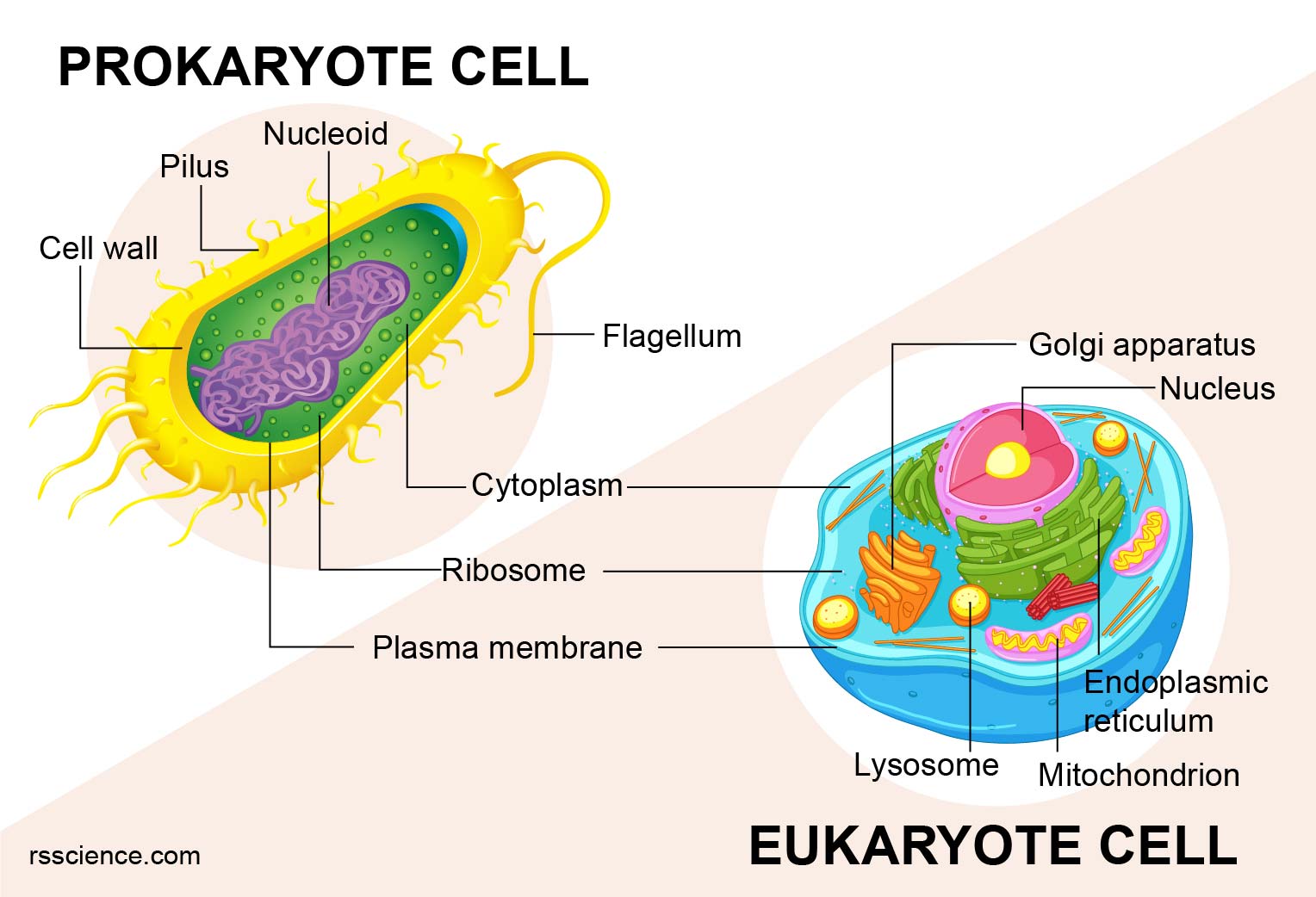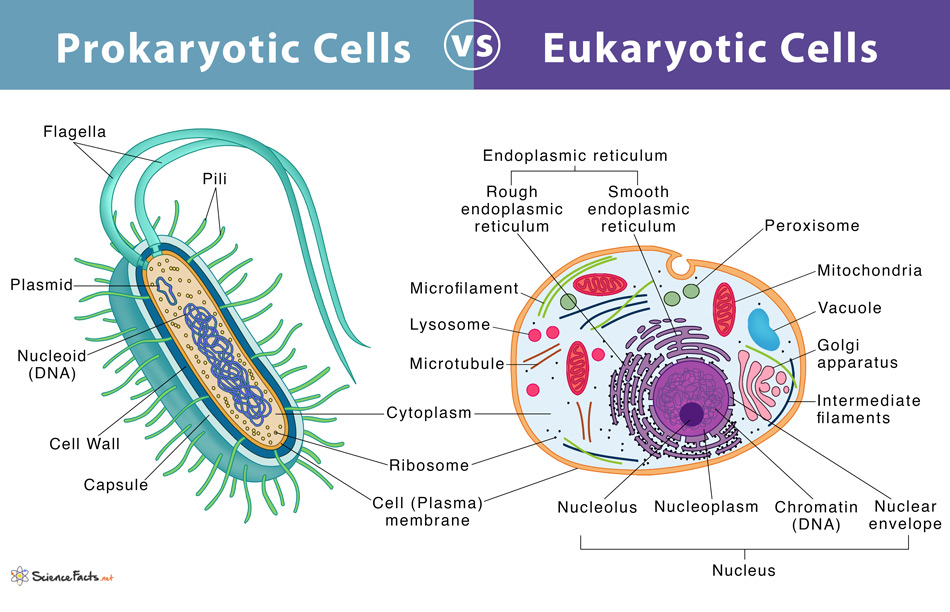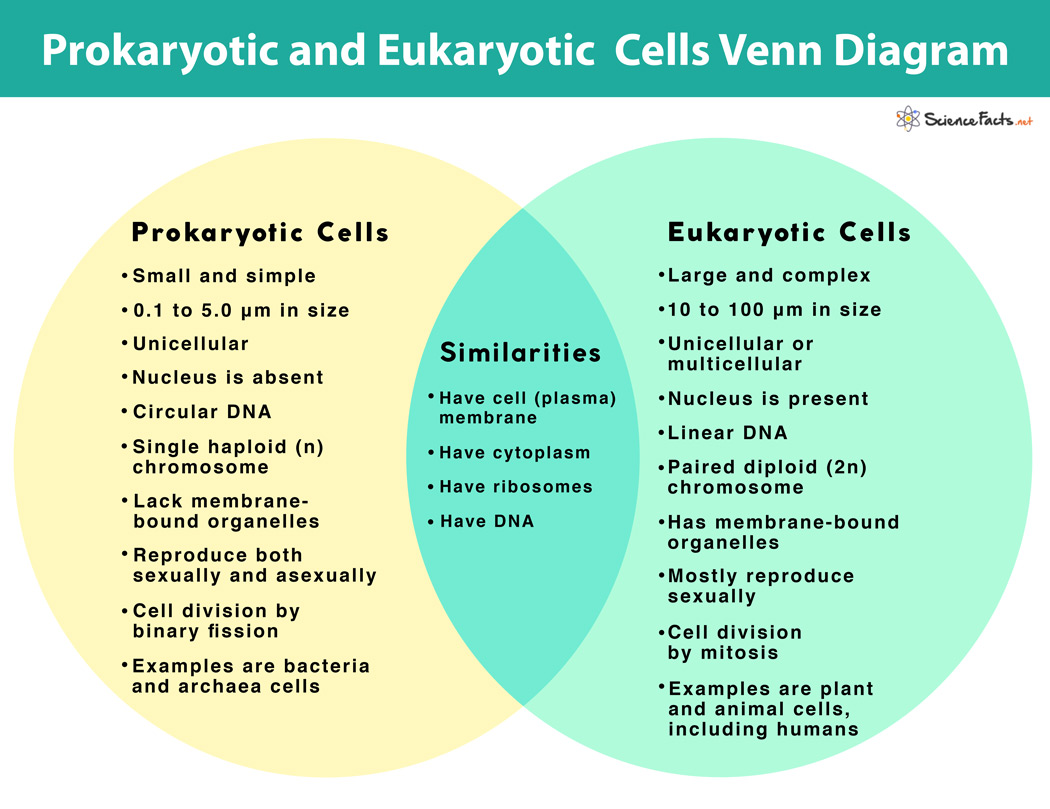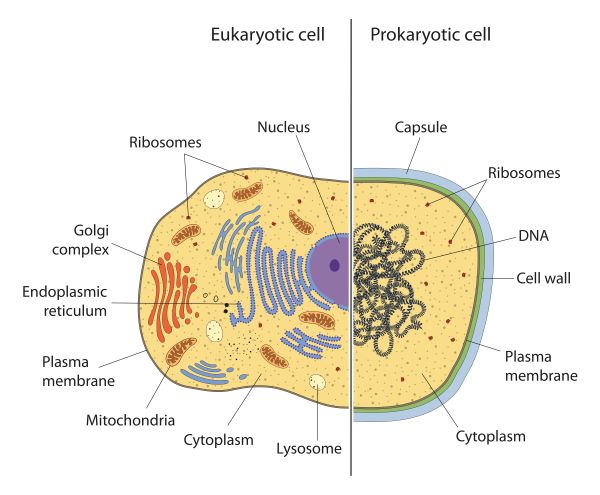prokaryote vs eukaryote
Which is large and which is small. The prokaryotic cells have no nucleus no organelles and a very small amount of DNA.

Eukaryotes And Prokaryotes What Are The Similarities Differences And Examples Rs Science
Write in the similarities and differences between prokaryotic and eukaryotic cells.

. Most significant is the lack of a nucleus in prokaryotic cells as well as membrane-based organelles found in all eukaryotic cells. Prokaryotes are organisms that consist of a single prokaryotic cell. They all have a cell membrane ribosomes and DNA as prokaryotic cells do.
The existence of two classes of cells without any intermediate type represents one of the most fundamental evolutionary separations in the living world. Eukaryotes as well as protists a miscellany group made up of eukaryote-like plant animal and fungi missing one or more characteristics to be defined as purely eukaryotic differ greatly from prokaryotes in structure. Cells of animals plants and fungi are called eukaryotic cells.
The boxes below r epresent the th ree domains th at all. In eukaryotes vertebrates dont have a cell wall but plants do. Does not have a nucleus.
On the other hand the eukaryotic cells have nucleus and cell organelles and the amount of DNA present is large. Eukaryotic Cells Prokaryotic vs. In prokaryotic cells the true nucleus is absent moreover membrane-bound organelles are present only in eukaryotic cells.
They range from 10100 μm in diameter and their DNA is contained within a membrane-bound nucleus. Prokaryotes and Eukaryotes are the two fundamental or basic classes of cells. Eukaryotes Size of cell Typically 02-20 m m in diameter.
Eukaryotes do have a. Prokaryotic cells have no mitochondria. The most obvious difference between them is that prokaryotes have no nuclei but there are four major differences between a eukaryotic and prokaryotic cell.
Typically 10-100 m m in diameter. Prokaryotic vs Eukaryotic Cells Worksheet. They are capable of more advanced functions.
Bacteria Archaea and Eu karya. Eukaryotes Workbook is a common core activity book that teaches students about the differences between prokaryotes and eukaryotes. Eukaryot ic Cells.
The capsule has a sticky surface area so it allows prokaryotes to cling to surfaces such as your skin and your teeth. Prokaryotic- microscopic eukaryotic- mostly large. Eukaryotic cells are found in plants animals fungi and protists.
Eukaryotic cells are more complex than prokaryotic cells. Where are the enzymes energy-producing organelles of prokaryotes found. It also covers the parts of the cell and contains parts of the cell study cards as well.
Most prokaryotic cells have a rigid cell wall that surrounds the plasma membrane and gives shape to the organism. Other major differences between prokaryotic and eukaryotic cells are that prokaryotic cells are exclusively unicellular while the same does not apply to eukaryotic cells. Some prokaryotes are enclosed by an additional layer.
One major difference is the fact that prokaryotic RNAP is made up of fewer subunits that eukaryotic. Eukaryotic is the type of cell eukaryotes are organisms that have those types of cells. This layer is called the capsule.
Prokaryotes are mostly unicellular organisms that lack nuclei and membrane-bound organelles. Comparison Between Prokaryotic and Eukaryotic Cells. Eukaryotic Cells By Dr.
Organisms can b e classified in. Eukaryotes true nucleus DNA in linear arrangement chromosomes DNA associated with histone nonhistone proteins DNA in nucleus surrounded by nuclear envelope Specialized mitotic apparatus involved in. Prokaryotic and eukaryotic cells are the only kinds of cells that exist on Earth.
Their cell structure is simpler than the cells of animals plants and fungi. Nearly every eukaryotic cell has mitochondria. Prokaryotes are organisms made up of cells that lack a cell nucleus or any membrane-encased organelles.
Prokaryotes are structurally and evolutionarily more primitive to eukaryotes. No prokaryotic cell has a nucleus. This Amoeba Sisters video starts with providing examples of prokaryotes and eukaryotes before comparing and contrasting prokaryotic cells with eukaryotic cel.
The structure and chemical composition of the DNA in both the eukaryotic and prokaryotic cells are different. Difference Between Eukaryotic And Prokaryotic Cells. Nucleus No nuclear membrane or nucleoli nucleoid True nucleus consisting of nuclear membrane nucleoli.
Eukaryotic RNAPII as stated previously has 12 subunits Rpb1-Rpb 12 while prokaryotic core RNAP contains only one subunit but has multiple domains alpha beta beta prime and omega. Means nucleus or chromosome. Every eukaryotic cell has a nucleus.
They are mainly distinguished by their size and internal structures. Cells of bacteria are called prokaryotic cells. Cells with NO NUCLEUS or membrane bound organelles.
AP Environmental Science APES101 Amoeba Sisters Vide o Recap. Carmen Rexach Mt San Antonio College Microbiology. Also while promoter specific initiation in eukaryotes.
Eukaryotes include larger more complex organisms such as plants and animals. Eukaryotes are organisms made up of cells that possess a membrane-bound nucleus that holds genetic material as well as membrane-bound organelles. Has DNA Has a nucleoid condensed circular DNA Can have a cell wall Unicellular Multicellular Has linear DNA in a nucleus Membrane-bound organelles Larger 10-100 um Smaller 1-5 um No membrane bound organelles.

Prokaryotes Vs Eukaryotes Definition And Characteristics

Prokaryotes Vs Eukaryotes What Are The Key Differences Technology Networks

Prokaryotes Vs Eukaryotes Definition And Characteristics
/what-are-prokaryotes-and-eukaryotes-129478-v41-5b69b4c546e0fb0025628d06.png)
What Are The Differences Between Prokaryotes And Eukaryotes

Prokaryotes Vs Eukaryotes What Are The Key Differences Technology Networks

Prokaryotes Vs Eukaryotes Biology Dictionary

What S The Difference Between Prokaryotic And Eukaryotic Cells Howstuffworks

0 Response to "prokaryote vs eukaryote"
Post a Comment